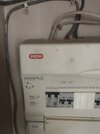I watched and listened to a lecture on the new amendments, and it was an eye opener to me, I had read about escape routes, but I had not understood what was mean, the escape route is the non decorated stair way with no carpets, often made of concrete where the only electrics are the lights required to see ones way out, the standard corridor is not considered as an escape route.
I think this is repeated many times, what was in the mind of the people writing the regulations is not always what the people reading the regulations think it is telling them.
This is not just electrician regulations, seen it were local authorities have published documents saying how TRV heads on radiators form zones, and there is not requirement for any other zone valves.
It seems all down to English comprehension, do you remember doing it at school, now actually taught as "Coms" in collages, although not sure even the lecturers are sure they are getting it right.
This has caused problems in Wales as official documents need to be available also in Welsh, and to translate BS 7671 would be some mammoth task to ensure no mistakes, it not as simple as translate word to word as a small house in Welsh would be normally called a toilet in English.
These pages see where we try and read the regulations and laws and interpret them to work out what is allowed, but in many cases it is not one book or regulation but many which interact with each other. So we have the IP rating, which decides a finger is 12 mm diameter, (IP2X) and a wire I think 1 mm diameter (IP4X) and from the top need to stop a wire and from sides and below a finger.
The consumer unit does not want to give you a shock when you touch it, but it also wants to retain burning parts for a reasonable time, the metal consumer unit powder sprayed the coating is not very thick and can easy be damaged, so there is a trade off, plastic is less likely to cause a shock when you touch it, but metal less likely to allow burning parts to escape, the metal is bonded to earth, but since the RCD is often within the consumer unit the CU itself is not RCD protected, only parts outside the CU have RCD protection, so we should isolate else where before going into an distribution unit in case a fault has caused there to be a loose wire.
We have seen this knee jerk reaction before, where we at one time even bonded metal window frames, we are in essence looking at a risk assessment, and to decrease the risk or fire which in turn increases the risk of electric shock is a balancing act.
Using silicon sealant can help make the top comply with IP4X but is also retains heat, so you only want just enough, don't go mad with it, common for fuse wire and like to be stored on top of a distribution board, clearly don't want it to fall inside. But in the main it is common sense rather than following regulations to the letter.
We hide behind the regulations, we can claim 'not my fault' when some thing goes wrong, as it complied. My mother never used an electric drill and was in a wheel chair, so having RCD protection because a wire was less than 50 mm deep did not make it safer for her, RCD so if she dropped the kettle in the sink yes, but not in the wall, so I would not expect the lack of a RCD on lighting circuits will really cause much danger.
However as a primary school kid I poked my fingers up the light socket where the bulb was missing to feel what was inside, did not repeat it, but learnt the hard way electric bites, you can get BA22d lamp holders where the pins are not live until bulb fitted, but rare, and called BA22d because the hole is 22 mm across, which is clearly more than the 12 mm of the IP rating, we also have E27 and E14 again both over 12 mm and rarely have safety features to stop you getting a shock, in the ceiling OK, but with a table lamp, clearly a danger once bulb is removed. MK do make a safety BA22d lamp holder (Logic Plus) where "Automatically shield contacts by means of a shutter when the lamp is removed" but not normally found with pendent lamps, not looked to see if available with E27?
So common sense, with a CU above the kitchen door unlikely a toddler will stick its fingers in the holes, under the stairs in what I always called the glory hole, made famous by Harry Potter, then yes likely toddler could play with it.
 www.screwfix.com
www.screwfix.com



